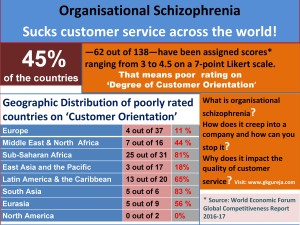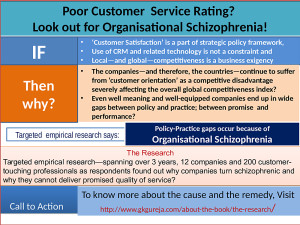Sift through the 400-page WEF’s Global Competitiveness Report 2016-17, to see how each participating country fares on ‘degree of customer orientation’ and you get a picture that leaves much to be desired (infographic). Ranking of countries on ‘customer orientation’ is based on the response of a group of local business executives to a question: “In your country, how well do companies treat customers?” A country’s ranking, is, therefore, essentially, a reflection of the degree of customer orientation of the country’s business enterprises.
Customer Satisfaction: a Strategic Priority
It is no longer a matter of academic debate that customer satisfaction has long become a strategic priority for business organisations to survive the ever challenging local as well as global competition. Many research studies have revealed that close to 80 percent of the CEOs consider customer satisfaction as one of the top 3 priorities and close to 40 percent consider ‘delivering positive customer experience’ as priority number one.
The latest Global Competitiveness report covers 138 countries all across the World. A quick internet survey would confirm that irrespective of the geographical region they belong to, all the countries, are in touch with the latest developments in the field of consumer behaviour. One would imagine that they are aware of the mounting evidence that those companies which have chosen to strongly pursue ‘customer first’ policy are increasingly returning better shareholder value over a longer term period. However, what does it take to convert declared customer policy into cogent operating practices?
Drivers of Customer Service Quality
A company would be eminently well equipped to deliver excellent customer service if the following drivers of service quality are firmly in place:
- unambiguous customer-policy guidelines,
- clear and updated understanding of customers’ expectations,
- service standards that meet—or preferably, exceed—those expectations,
- appropriate organizational structure,
- stabilized and technology supported business processes,
- emotionally engaged and professionally enabled employees who can meet the set service standards with confidence,
- Work place climate that enables clear and concise organisational communication.
Many companies all over the world can rightfully claim that they have the necessary wherewithal for delivering promised quality of customer service. Nonetheless, the common experience is that the customers find wide gaps between what is promised and what, in customers’ perception, is actually delivered at the operating level. It is not uncommon to experience faked empathy and illusive logic to wriggle out of a default committed in the process of delivering a product or post sales support. That is what leads to poor rating on customer orientation.
A few questions arise:
- The question is why does disconnect occur between policy and practice; between intent and implementation?
- Why does schizophrenia begin to characterize people’s behavior?
- Why mission statements turn into mere posters?
- Why as many as 62 out of 138 countries spread across various geographic regions get poor ratings on customer orientation?
- Is there a common phenomenon prevailing in most companies in various countries including those which have been rated higher?
The blog ‘Can Schizophrenic Organisations deliver...’ provides you some answers and introduces you to a book embodying the findings of a targeted empirical research. Organisational Schizophrenia: Impact on Customer Service Quality, deals comprehensively with the human and organisational game playing that creates schizophrenia and also suggests what can company leadership do about it. The WEF Global Competitiveness Report 2016-17 makes my research and the related book even more relevant across the globe and hence I decided to share this information.


